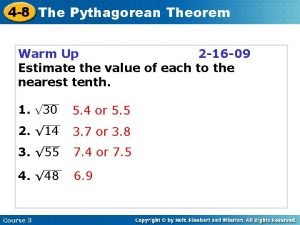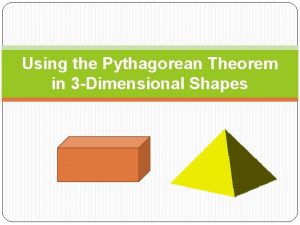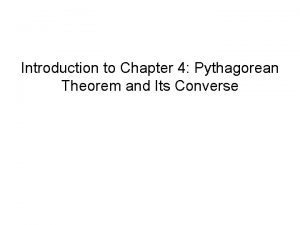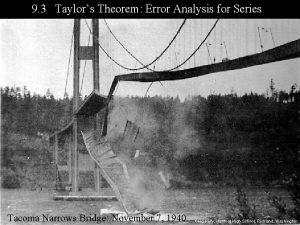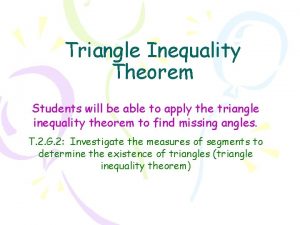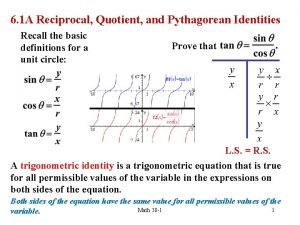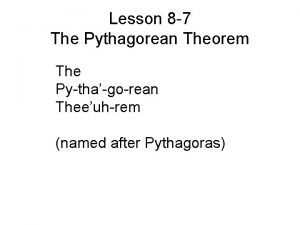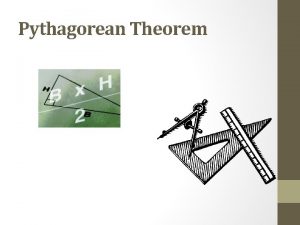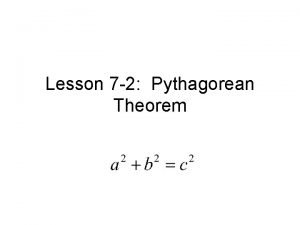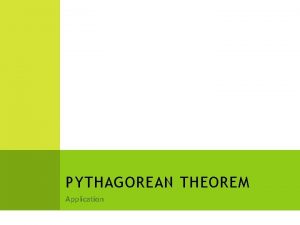Pythagorean Theorem Who is Pythagoras Pythagoras was a













- Slides: 13

Pythagorean Theorem

Who is Pythagoras? Pythagoras was a Greek philosopher who lived from 569 BC to 475 BC. He is most famous for theorem named after him: The Pythagorean Theorem. While it remains unclear if Pythagoras actually solved the 1, 000 year old Babylonian calculation, it is credited to his name due to his discovery of it.

The Theorem 2 a + 2 2 b =c c a b Theorem: The sum of the squares of the lengths of the legs of a right triangle is equal to the square of the length of the hypotenuse.

It has to be RIGHT In order for this theorem to work, we must be measuring the sides of a right triangle. A triangle is only considered to be a right triangle if one of it’s angles measures 90° This little square symbolizes that this angle is a right angle

Key Terms c a “Legs” are the sides of the triangle that form the 90° angle b The hypotenuse is the longest side of the right triangle and is found opposite of the right angle

Test the formula Step one : determine the legs and the hypotenuse legs : a=3 b=4 hypotenuse : c= 5 5 3 Now place this information into the formula: a 2 + b 2 = c 2 32 + 4 2 = 52 9 + 16 = 25 4 √ 25 = 5

Practice using the Theorem In this case what numerical values would represent a, b and c from our theorem? – a = 12 b=9 c=x x 12 Plug this information into the formula : a 2 + b 2 = c 2 122 + 92 = x 144 + 81 = 225 Remember that 225 is not the final answer, you must take the square root of that to solve for x √ 225 = 15 = x =c 9

When the hypotenuse is already given 13 12 a=x x b = 12 x 2 + 122 = 132 x 2 + 144 = 169 x 2 = 25 x=5=a c= 13

Important Remember that the Pythagorean theorem only works if the triangle is a right triangle For example, if a triangle has sides that measure 8, 10, and 7, is it a right triangle? Let a = 8, b= 7, and we know c must equal 10 because the hypotenuse is the longest side. 82 + 72 ≠ 102 so we can conclude that a triangle with those side measurements is NOT a right triangle

Have you noticed? The set of three numbers that work to solve the Pythagorean theorem are known as Pythagorean triples. These triples can only consist of: – All even numbers • Examples: (6, 8, 10) (10, 24, 26) ( 12, 16, 20) – Two odd numbers and an even number • Examples: (3, 4, 5) (5, 12, 13) (7, 24, 25)

How the Theorem Works All the triangles below are the same size, and have just been rotated 90° c a b When you put the triangles together without any further rotations, they form a square where the sides are equal to c c

Modern Uses of the Pythagorean Theorem

Modern Uses of the Pythagorean Theorem
 Green to stokes
Green to stokes Pythagorean theorem warm up
Pythagorean theorem warm up A one dimensional figure
A one dimensional figure State and prove pythagoras theorem
State and prove pythagoras theorem The pythagorean theorem and its converse worksheet
The pythagorean theorem and its converse worksheet Lagrange error formula
Lagrange error formula Pythagorean inequality theorem
Pythagorean inequality theorem Theorems on triangle inequalities
Theorems on triangle inequalities Pythagorean theorem poster project
Pythagorean theorem poster project Pythagorean theorem objectives
Pythagorean theorem objectives Reciprocal equation definition
Reciprocal equation definition Lesson 8-1 the pythagorean theorem answers
Lesson 8-1 the pythagorean theorem answers Dmt dynasty models
Dmt dynasty models Pythagorean theorem odyssey
Pythagorean theorem odyssey

